| C H A P T E R 4 |
|
Maintaining the Sun Fire X2250 Server |
This chapter describes how to add, replace, and configure components in the Sun Fire X2250 server after it has been set up.
This chapter contains the following sections:
To determine and isolate a faulty component, refer to Section , Performing Diagnostics.
You need the following tools and supplies for performing Sun Fire X2250 server maintenance procedures.
Before removing the system’s top cover, read the following sections. These sections contain important electrostatic discharge (ESD) precautions, along with preinstallation and postinstallation instructions.
ESD can damage your processor, disk drives, expansion boards, and other components. Always observe the following precautions before you install a system component.
Always perform the following steps before you install any component:
1. Turn off the system and all of the peripherals connected to it.

|
Caution - Failure to properly turn off the system before you start installing components can cause serious component damage. |

|
Caution - Follow the ESD precautions described in Section 4.2.1, ESD Precautionswhen handling a system component. |
See Section 4.3, Powering Off the Server and Removing the Cover for the appropriate procedure for removing the cover from the server.
Perform the following steps after installing a server component.
1. Ensure that all of the components are installed as described in the component replacement instructions.
See Section 4.5, Component Replacement Procedures.
2. Reinstall any PCI-Express (PCIe) cards or peripherals that you had previously removed.
See Section 4.5, Component Replacement Procedures.
3. Reinstall the system’s cover.
See Section 4.3, Powering Off the Server and Removing the Cover.
4. Connect all external cables to the system.
See Section 1.4, Powering On and Powering Off the Server.
For your safety, perform this procedure when you are powering off the system and removing the cover for a maintenance procedure in this chapter.
1. If the operating system (OS) is running, perform a shutdown of the OS, and then press and release the platform Power button on the front panel.
2. Turn off all peripheral devices connected to the system.
3. Disconnect the AC power on the back panel of the server (see FIGURE 1-2).
4. Label and disconnect all peripheral cables and all telecommunication lines connected to I/O connectors or ports on the back panel of the system.

|
Caution - The system’s printed circuit boards and hard disk drives contain components that are extremely sensitive to static electricity. |
5. Before handling components, attach a wrist strap to a chassis ground (any unpainted metal surface).
6. Loosen the two captive screws securing the cover to the chassis (see FIGURE 4-1).
7. Pull the cover slightly toward the back of the server and then straight up to remove it.
8. Lift the cover and remove it.
FIGURE 4-1 Removing the Server Cover
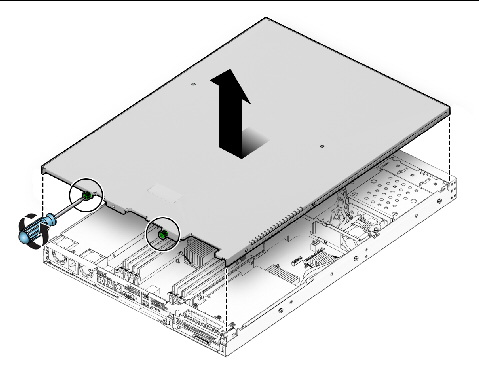
FIGURE 4-2 Sun Fire X2250 Server System Components
The following components are customer-replaceable units (CRUs):
The following component should be replaced only by trained field service technicians:
The following procedures describe how to remove and replace an I/O board.
1. Power off the server, including any attached peripherals, and disconnect the server from the electrical outlet. Refer to Section 4.3, Powering Off the Server and Removing the Cover.
2. Remove the screws securing the I/O board to the hard disk drive (HDD) cage.
FIGURE 4-3 Removing the I/O Board
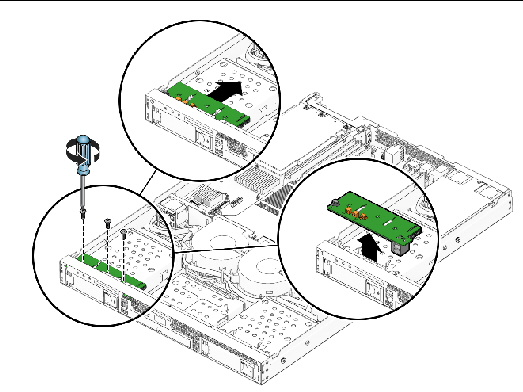
3. Pull the I/O board back slightly, then upward to disengage the board from the guides on top of the HDD cage.
4. Remove all cables connected to the I/O board.
1. Position the I/O board on top of the HDD cage so the openings on the board line up with the guides on top of the HDD cage.
FIGURE 4-4 Installing the I/O Board
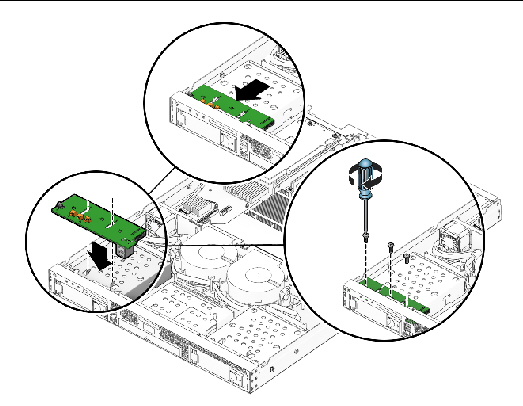
3. Gently push the I/O board down to engage the guides and push the board forward to secure it.
4. Fasten the screws to secure the I/O board to the mounting bracket.
5. Check the routing of all cables for obstructions, and then reinstall the cover as described in Section 4.3, Powering Off the Server and Removing the Cover.
| Note - Many of the illustrations in this section show multiple PCIe slots on the motherboard. The Sun Fire X2250 server motherboard will only have a single PCIe slot. |
The PCIe riser assembly installed in the server is a low-profile, half-length x16 dual connector card, supporting up to 35W cards.
| Note - Graphics cards are not currently supported for the x16 riser assembly. Refer to the Sun Fire X2100 M2 Server Product Notes for specifics on limits on supported cards for this riser assembly. |
FIGURE 4-5 PCIe riser assembly: x16 assembly (left) x8 assembly (right)

The following procedures describe how to remove or install a riser assembly and PCIe card.
To remove the riser assembly and PCIe card:
1. Power off the system and remove the cover as described in Section 4.3, Powering Off the Server and Removing the Cover.
FIGURE 4-6 Removing the PCIe Card Riser Assembly
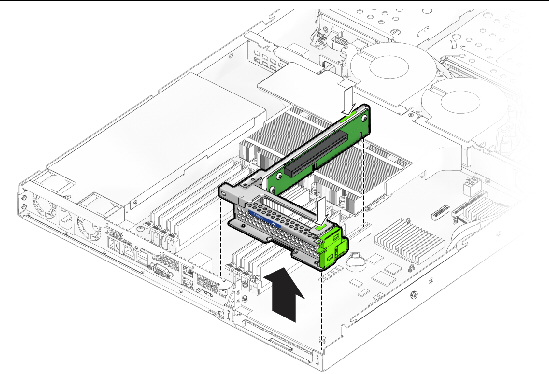
2. Placing your fingers on the two green areas on the riser assembly, pull the assembly upward and out of the chassis. See FIGURE 4-6.
3. Unlatch the PCIe card and remove the card from the PCIe card riser assembly connector. See FIGURE 4-7.
FIGURE 4-7 Removing a PCIe Card
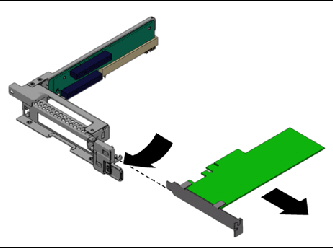
To install the PCIe card and riser card assembly:
1. If necessary, remove the riser card filler panel. See FIGURE 4-8.
FIGURE 4-8 Removing the PCIe Riser Card Filler Panel

2. Insert the new PCIe card into the riser assembly and fasten the latch to secure the card. See FIGURE 4-9.
FIGURE 4-9 Installing the PCIe Card
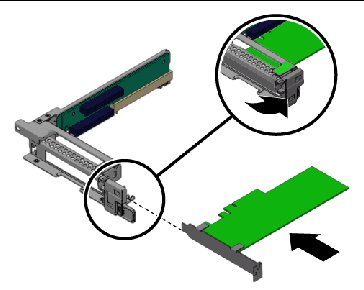
3. Reinstall the riser assembly into the connector on the motherboard. See FIGURE 4-10.
FIGURE 4-10 Installing the PCIe Card Riser Assembly

4. Check the routing of all cables for obstructions, and then reinstall the cover as described in Section 4.3, Powering Off the Server and Removing the Cover.
The following procedures describe how to remove and replace a hard disk drive (HDD) and carrier.
To remove the HDD and carrier:
1. If you are not using an integrated-mirroring (IM) configuration, you must power off the server before removing an HDD; it is not necessary to remove the cover. Power off the system as described in Section 4.3, Powering Off the Server and Removing the Cover.
If you are using an IM configuration, start with Step 2.
2. Squeeze the release latch on the HDD and carefully swing the arm to the left as far as it will go.
FIGURE 4-11 Removing a Hard Disk Drive
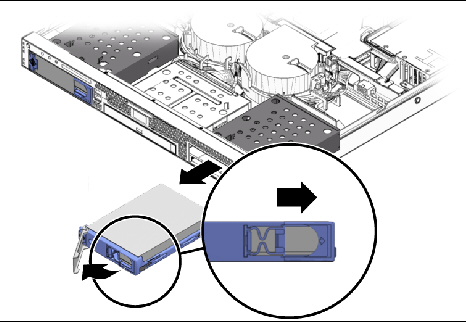
3. Grasp the carrier bezel with both hands and carefully pull the carrier out of the drive bay.
| Note - Avoid using the arm to remove the carrier. |
4. Reinsert the HDD and carrier into the server as described in Section 4.5.3.2, Installing an HDD and Carrier.
To install the HDD and carrier:
1. Squeeze the release latch on the HDD and carefully swing the arm to the left as far as it will go.
FIGURE 4-12 Installing a Hard Disk Drive
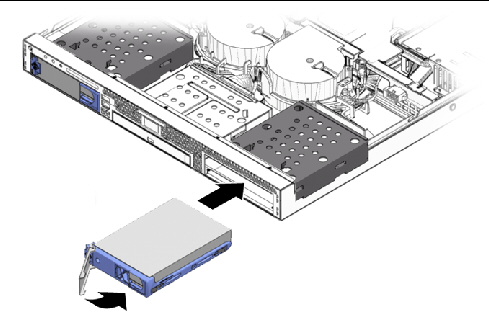
2. Grasping the body of the drive in both hands, carefully guide the connector end of the carrier into the drive bay, sliding the carrier into the bay until the latch engages and partially closes itself.
3. Push the latch forward until it locks to secure the carrier in place.
The following procedure describes how to replace the hard disk drive (HDD) backplane assembly for HDD 0 and HDD 1.
1. Remove the HDD as described in Section 4.5.3.1, Removing an HDD and Carrier.
This ensures that the HDD is detached from the HDD backplane assembly.
2. Remove the screws fastening the backplane assembly to the server chassis.
3. Carefully lift the HDD backplane assembly from the server chassis.
4. Disconnect the HDD power and SATA cables from the rear of the HDD backplane assembly.
5. Remove the screws fastening the HDD backplane to the backplane bracket.
FIGURE 4-13 Removing the HDD Backplane Assembly

To install the HDD backplane assembly:
1. Fasten the screws to secure the HDD backplane to the backplane bracket.
2. Reinstall the HDD power and SATA cables to the rear of the HDD backplane assembly.
3. Reinsert the HDD assembly into the server chassis.
4. Fasten the screws to secure the HDD backplane assembly to the server chassis.
FIGURE 4-14 Replacing the HDD Backplane Assembly
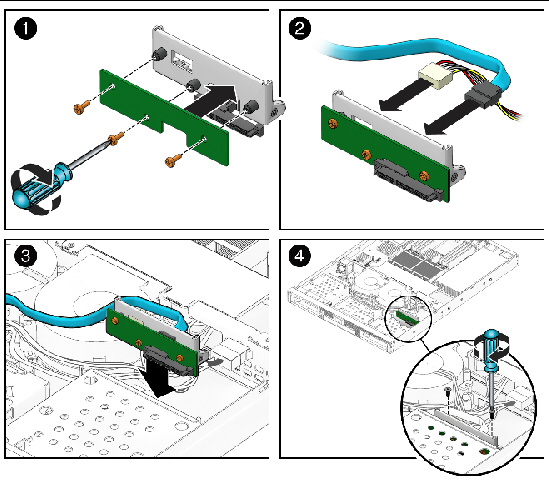
5. Reinsert the HDD as described in Section 4.5.3.2, Installing an HDD and Carrier.
6. Check the routing of all cables for obstructions, and then reinstall the cover as described in Section 4.3, Powering Off the Server and Removing the Cover.
The following procedure describes how to replace the optical disk drive (ODD) assembly. If you are not replacing a DVD drive, go to Section 4.5.5.2, Installing the ODD Drive Assembly.
To remove the ODD (DVD or CD) drive assembly:
1. Power off the system and remove the cover as described in Section 4.3, Powering Off the Server and Removing the Cover.
2. Unfasten the drive ribbon cable from the ODD drive.

|
Caution - Use care with the small flat cables. They are extremely fragile. |
FIGURE 4-15 Removing the DVD Drive Assembly
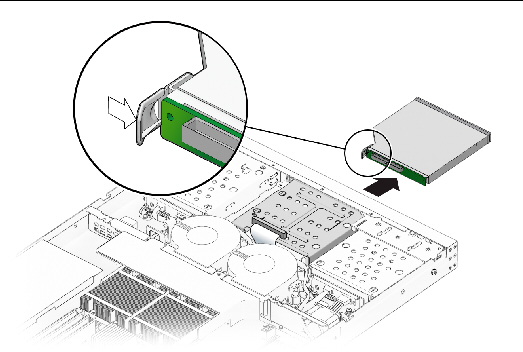
3. Push the latch on the back of the ODD drive toward the drive until the ODD drive springs forward out of the chassis.
4. Pull the ODD drive out the front of the chassis.

|
Caution - Move the assembly by grasping it by its sides. Do not push on the
DVD-ROM tray. |
To install the ODD (DVD or CD) drive assembly:
1. If necessary, remove the filler panel in front of the ODD drive slot on the front panel.
Put your finger or a screw driver behind the slot on the right side of the filler panel and pull the panel outward.
FIGURE 4-16 Removing the ODD Filler Panel

2. Position the ODD drive in front of the ODD drive slot on the front panel.
3. Push the ODD drive into the drive slot until the drive clicks into place.
FIGURE 4-17 Installing the ODD Assembly
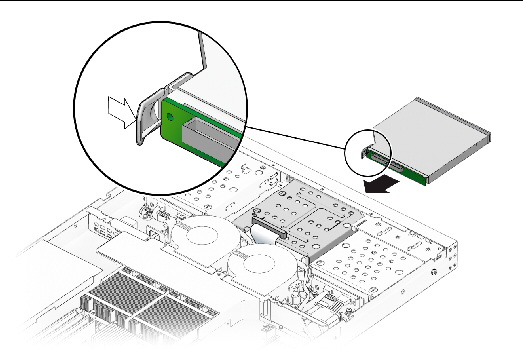
4. Reinstall the ODD drive cable.
5. Check the routing of all cables for obstructions, and then reinstall the cover.
The following procedures describe how to replace the system air duct.
1. Power off the system and remove the cover as described in Section 4.3, Powering Off the Server and Removing the Cover.
2. Remove the screw fastening the air duct to the chassis divider.
3. Pull the air duct up and out of the chassis.
FIGURE 4-18 Removing the Air Duct
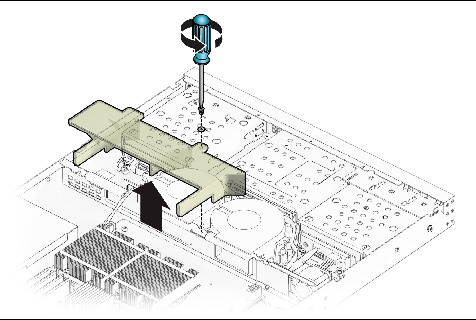
1. Position the air duct into the chassis as shown in FIGURE 4-19, aligning the baffle with the screw hole and opening in chassis divider.
2. Fasten the screw that attaches the air duct to the chassis divider.
FIGURE 4-19 Installing the Air Duct
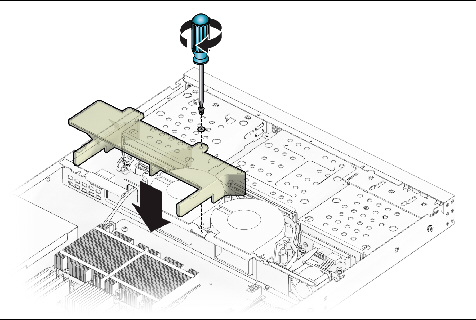
The following procedures describe how to replace the power supply.
1. Power off the system and remove the cover as described in Section 4.3, Powering Off the Server and Removing the Cover.
2. Remove the air duct. See Section 4.5.6.1, Removing the Air Duct.
3. Disconnect the three power supply cables from the motherboard.
4. Perform the following to disconnect the power supply connection from the hard disk drives (HDDs).
a. Disconnect the HDD power harness plug from the power supply unit.
b. Squeeze the tabs on the connector and push it through the cut out in the chassis bulkhead.
FIGURE 4-20 Removing the Power Supply

6. Lift the power supply out of the chassis.
1. Position the power supply over the chassis power-supply cage.
2. Insert the power supply into the chassis and push it forward so that it is flush with the back panel.
3. Install the power supply and fasten the captive screws.
FIGURE 4-21 Installing the Power Supply

4. Connect three of the power supply cables to the motherboard. See FIGURE 4-38.
5. Reinstall the cable clips to the power supply cables.
This ensures that the power supply cables will not obstruct the CPU airstream.
6. Perform the following procedures to reconnect the power supply to the hard disk drives (HDDs).
a. Squeeze the tabs on the connector and push it through the cut out in the chassis bulkhead.
a. Reconnect the HDD power harness plug to the power supply unit.
7. Replace the air duct. See Section 4.5.6.2, Installing the Air Duct.
8. Check the routing of all cables for obstructions, and then reinstall the cover.
The following procedures describe how to replace the single system fan module.
To remove the system fan module:
1. Power off the system and remove the cover as described in Section 4.3, Powering Off the Server and Removing the Cover.
2. Pull the fan module upward to remove it from the chassis.
FIGURE 4-22 Removing the Fan Module

3. Unplug the fan’s power connector from the connector on the fan harness.
| Note - Note exactly which motherboard connector was connected to the fan. If you connect a fan to an incorrect connector, the SP cannot correctly identify a fan failure. |
To install the system fan module:
1. Position the fan so that the arrow on top of the fan casing is facing the middle chassis divider.
2. Place the fan module in the chassis so that it fits over the small guideposts.
FIGURE 4-23 Installing the Fan Module
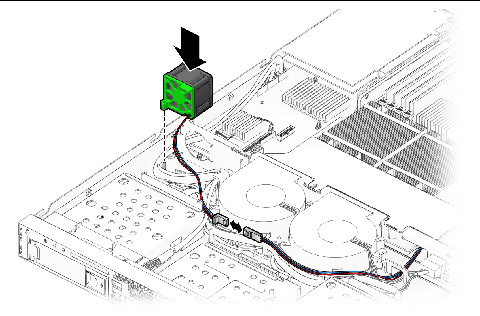
3. Gently push the fan down to secure it to the chassis.
4. Connect the fan connector to the appropriate connector on the fan harness.
5. Check the routing of all cables for obstructions, and then reinstall the cover.
The following procedures describe how to replace the dual blower module.
To remove the dual blower module:
1. Power off the system and remove the cover as described in Section 4.3, Powering Off the Server and Removing the Cover.
2. Remove the air duct as described in Section 4.5.6.1, Removing the Air Duct.
3. Remove the fan connector from the harness connector.
Other cables can be routed through the cable retaining channel. Disengage these cables from the channel before proceeding.
4. Unplug the fan’s power connector from the motherboard.
FIGURE 4-24 Removing the Dual Blower Module

5. Push in the green tabs on both sides of the dual blower module and simultaneously pull the fan module upward to remove it from the chassis.
To install the dual blower module:
1. Position the dual blower module so that it fits over the guideposts and the duct opening fits into the cutouts in the chassis divider.
FIGURE 4-25 Installing the Dual Blower Module
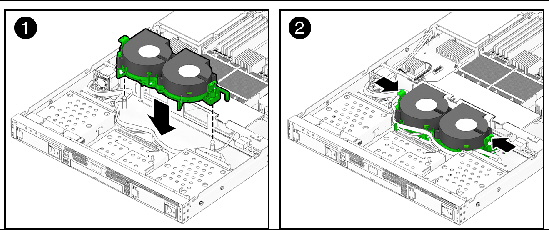
2. Gently push the blower module down, until you hear the side tabs click into place.
3. Connect the blower connector to the appropriate connector on the motherboard.
4. Connect the fan connector to the corresponding fan harness connector.
5. Route the cables through the wiring retainers on the blower module.
6. Check the routing of all cables for obstructions, and then reinstall the cover.
The following procedure describes how to remove and or install dual inline memory modules (DIMMs).
| Note - Keep in mind the following information and rules when you use the procedures in this section to replace or add DIMMs to the server. |
1. Power off the system and remove the cover as described in Section 4.3, Powering Off the Server and Removing the Cover.
2. Locate the DIMM connector in which you will install or replace a memory module.
Bank 0 is the bank closest to CPU 0 and Bank 1 is the bank closest to CPU 1. See FIGURE 4-26 and FIGURE 4-27.
FIGURE 4-26 Bank 0 DIMM Slot Locations
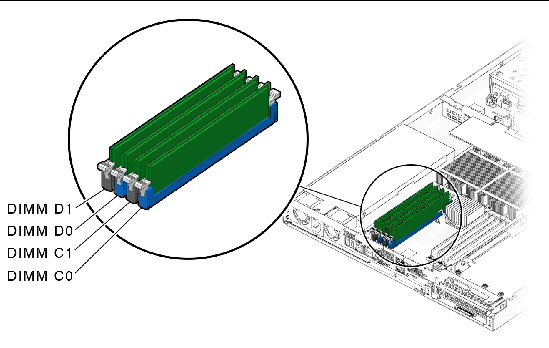
FIGURE 4-27 Bank 1 DIMM Slot Locations

3. Remove a DIMM by pressing down on the ejector levers at both ends of the memory module’s socket (see FIGURE 4-28).
4. Pull the DIMM up and out of the socket.
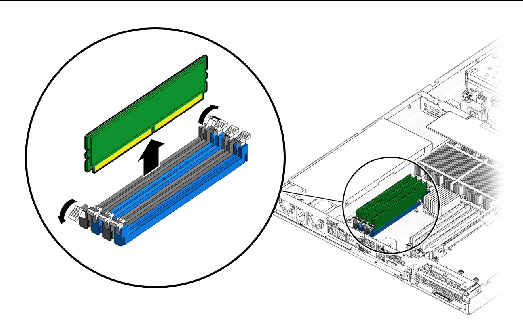
1. Refer to Section 4.5.10.1, DIMM Population Rules before installing DIMMs.
2. Ensure that the DIMM socket ejector levers are open (rotated outward) to allow the new module to be inserted.
3. Align the DIMM’s edge connector with the alignment key and insert the memory module into the connector.
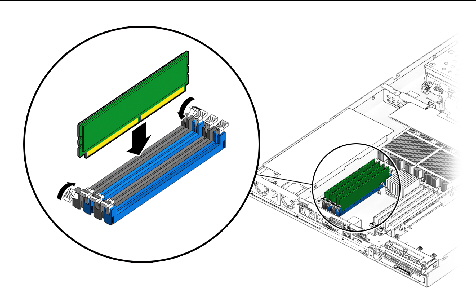
4. Using both thumbs, press the DIMM straight down into the DIMM slot until both ejector levers click, locking the DIMM in the DIMM slot.
| Note - The manufacturer and capacity of both modules in the same memory bank
(Banks A0-A1, B0-B1) must be identical. |
5. Check the routing of all cables for obstructions, and then reinstall the cover.
The system battery is a common CR2032 calculator battery.
You might need to replace the system battery if you know it is weak or if after any period of AC power loss, the BIOS loses its CMOS settings, or if the time-of-day clock loses time.

|
Caution - Do not attempt to open or service batteries. The battery contains lithium and can explode if not properly used, handled, or disposed of. |
1. Power off the system and remove the cover as described in Section 4.3, Powering Off the Server and Removing the Cover.
2. If a PCI-Express card is installed in your server, remove the card as described in Section 4.5.2, Replacing the PCIe Card and Riser Assembly.
3. Remove the system battery by gently pulling the clip away from the side of the battery and sliding the battery out of the battery holder (see FIGURE 4-30 for the location).
FIGURE 4-30 Removing the System Battery
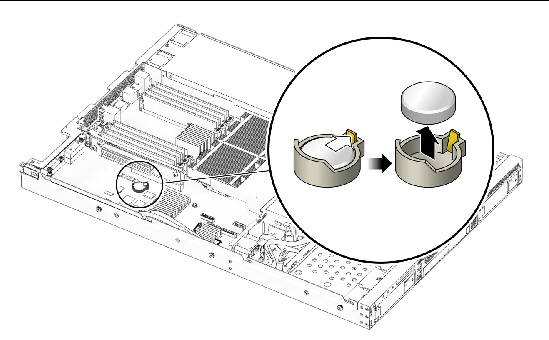
To install the system battery:
1. Insert the new system battery into the battery holder with the side labeled “+” facing upward.
FIGURE 4-31 Installing the System Battery
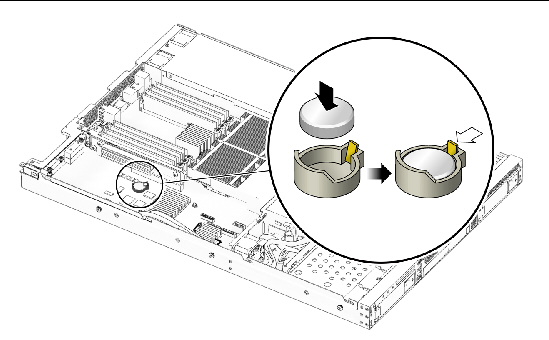
| Note - Replace the battery only with the identical model. |
2. Reinstall the PCI-Express card as described in Section 4.5.2, Replacing the PCIe Card and Riser Assembly.
3. Check the routing of all cables for obstructions and then reinstall the cover.
The following procedure describes how to replace a CPU. The Sun Fire X2250 server supports both single-CPU and dual-CPU configurations.
| Note - Replacement of a CPU and heatsink should only be done by trained service personnel. If you are adding a second CPU to a single CPU configuration, see Section 4.5.13, Installing a New CPU. |

|
Caution - Observe the appropriate ESD precautions in Section 4.2.1, ESD Precautionswhen handling the CPU. |
1. Power off the system and remove the cover as described in Section 4.3, Powering Off the Server and Removing the Cover.
2. Unfasten the four screws securing the heatsink to the board (see FIGURE 4-32).
FIGURE 4-32 Removing a Heatsink


|
Caution - The heatsink can become extremely hot. Be sure it has had sufficient time to cool before handling. |
3. Twist the heatsink slightly to the right or left to break the seal with the thermal grease.
4. Lift the heatsink away from the CPU.
5. Place the heatsink upside-down on a flat surface to prevent the thermal grease from contaminating other components.
6. Pull the socket release lever up to the fully open, perpendicular position.
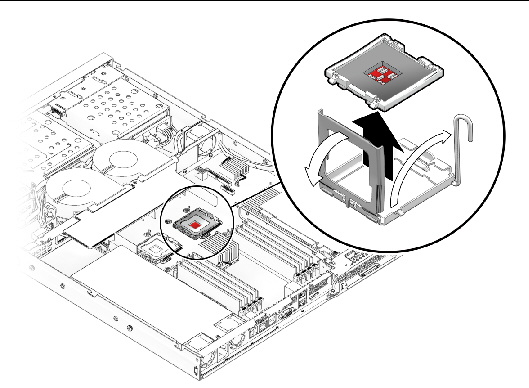
8. Lift the CPU out of the socket, leaving the release lever in the open position.
| Note - Ensure that no thermal grease that might be left from the heatsink comes into contact with the CPU socket or underside of the CPU chip. |
Follow these steps to install a CPU and heatsink if you are replacing a CPU. If you want to install a new CPU or install a second CPU into a formerly single-CPU system, see Section 4.5.13, Installing a New CPU.

|
Caution - Observe the appropriate ESD precautions in Section 4.2.1, ESD Precautionswhen handling the CPU. |
2. Ensure that the socket release lever is in the fully open, perpendicular position and the CPU cover is open (see FIGURE 4-34).
3. Align the small triangle, on the upper left corner of the CPU, with the triangle on the corner of the socket.
FIGURE 4-34 Installing the CPU
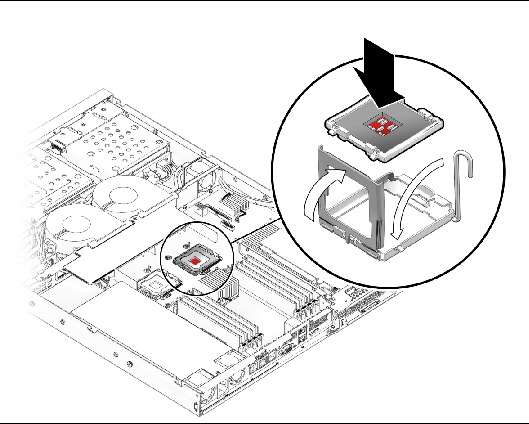
4. Insert the CPU into the socket.
5. When the CPU is fully seated in the socket, close the CPU cover.
6. Rotate the socket release lever down until it snaps into place, securing the CPU in the socket.
7. Use the entire syringe contents to apply thermal grease in a circular pattern to the top of the CPU.
| Note - If you are replacing an existing heatsink with a new heatsink, you do not need to use the syringe to add additional thermal grease to the heatsink, as new heatsinks are pre-greased. |
8. Gently distribute the thermal grease and remove any excess so that only an extremely thin, uniform layer remains. If any voids or crevices appear that could lead to air pockets, reapply the grease until you achieve a thin but compact consistency.
9. Use an alcohol pad to remove all thermal grease from the bottom of the heatsink.
10. Inspect the heatsink for dust and lint. Clean if necessary.
11. Carefully position the heatsink on the CPU, aligning it with the mounting posts to reduce movement after it makes initial contact with the layer of thermal grease.

|
Caution - If the heatsink is moved too much during its installation, the layer of thermal grease may become uneven, leading to component damage. |
12. Fasten the four screws attaching the heatsink to the motherboard. Alternate between the four screws, turning each screw two turns until all are securely fastened. See FIGURE 4-35.
FIGURE 4-35 Installing the Heatsink
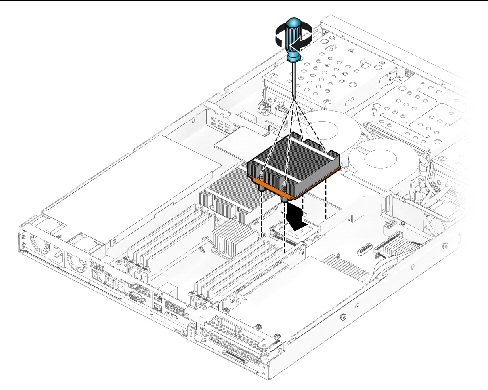
| Note - Replacement of a CPU and heatsink should only be done by trained service personnel. If you are replacing an already installed CPU, rather than adding a new one, follow the instructions in Section 4.5.12, Replacing a CPU and Heatsink. |

|
Caution - Observe the appropriate ESD precautions in Section 4.2.1, ESD Precautionswhen handling the CPU. |
To install a new CPU and heatsink:
2. If you are installing a second CPU into a formerly single-CPU system, you will need to remove the socket cover before installing the new CPU.
3. Ensure that the socket release lever is in the fully open, perpendicular position and the CPU cover is open (see FIGURE 4-34).
4. Align the small triangle, on the top left corner of the CPU, with the triangle on the corner of the socket.
FIGURE 4-36 Installing the CPU
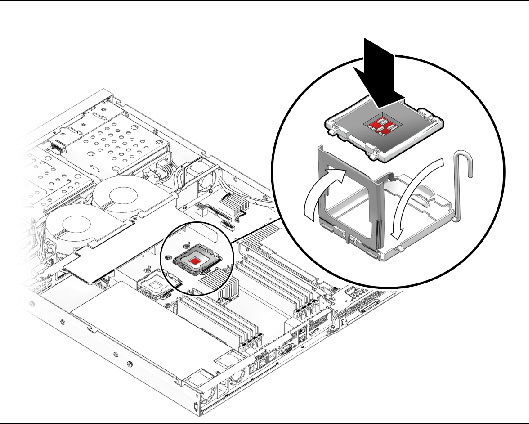
5. Insert the CPU into the socket.
6. When the CPU is fully seated in the socket, close the CPU cover.
7. Rotate the socket release lever down until it snaps into place, securing the CPU in the socket.
8. Inspect the heatsink for dust and lint. Clean if necessary.
9. Carefully position the heatsink on the CPU, aligning it with the mounting posts to reduce movement after it makes initial contact with the layer of thermal grease.

|
Caution - If the heatsink is moved too much during its installation, the layer of thermal grease may become uneven, leading to component damage. |
10. Fasten the four screws attaching the heatsink to the motherboard. Alternate between the four screws, turning each screw two turns until all are securely fastened. See FIGURE 4-37.
FIGURE 4-37 Installing the Heatsink
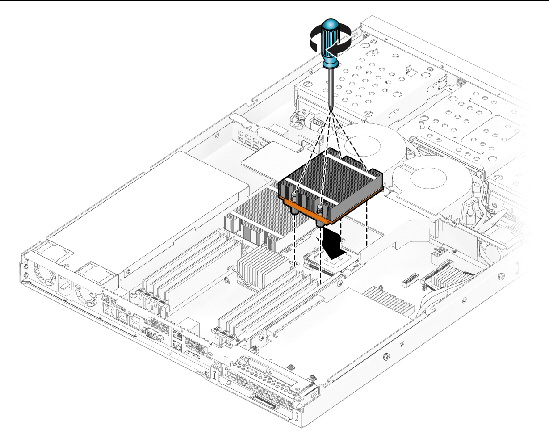
FIGURE 4-38 shows the routing of the cables and motherboard connector locations.
FIGURE 4-38 Cable Routing and Motherboard Cable Connections
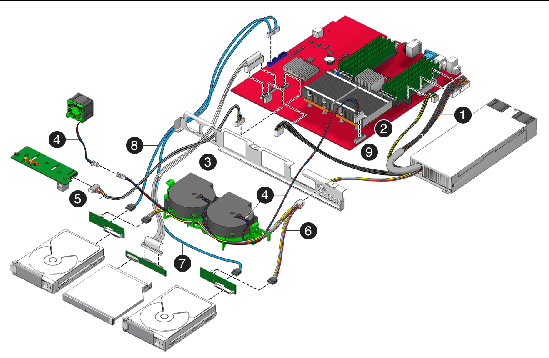
TABLE 4-2 describes the cables that are included with the associated component replacement kits..
|
ODD signal, hard drive power, I/O board signal, and two SATA signal cables |
|
TABLE 4-3 describes the motherboard cable connections.
The following procedures describe how to remove and install the Sun Fire X2250 server system motherboard.
| Note - The motherboard is not a CRU and should be replaced only by trained field service technicians. |
1. Power off the system and remove the cover as described in Section 4.3, Powering Off the Server and Removing the Cover.
2. Remove the PCIe card riser assembly installed on the motherboard (see Section 4.5.2, Replacing the PCIe Card and Riser Assembly) and the air duct (see Section 4.5.6, Replacing the Air Duct).
3. Disconnect all cables attached to the motherboard.
4. Remove the four screws from the heatsink (4 screws per heatsink installed).
| Note - Do not remove the screws that secure the CPU heatsink assemblies mounting to the motherboard. |
5. Using a Phillips screwdriver, remove the seven Phillips screws that fasten the motherboard to the chassis.
6. Using a 5-mm nut driver, remove the screws attaching the serial connector to the chassis.
FIGURE 4-39 Removing the Motherboard

7. Pull the motherboard away from the chassis.
8. Remove the CPU and memory modules.
Refer to the following sections for information on removing and replacing the CPU and memory:

|
Caution - Observe proper ESD precautions in Section 4.2.1, ESD Precautionswhen handling the new motherboard. |
1. Center the motherboard on the chassis so that the screw holes in the motherboard align with the screw holes on the chassis.
2. Secure the seven Phillips screws that fasten the motherboard to the chassis. Torque screws to 8-9 inch-pounds.
3. Using a 5-mm nut driver, secure the screws attaching the serial connector to the chassis.
FIGURE 4-40 Installing the Motherboard
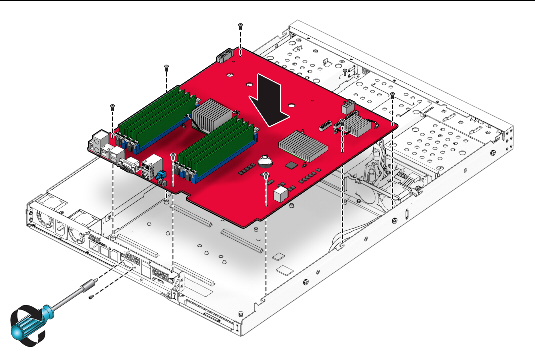
4. Replace the CPU and DIMMs as necessary.
Refer to the following sections for information on removing and replacing the CPU and memory:
5. Replace the PCIe card riser assembly and air duct.
6. Reconnect all internal system cables.
See Section 4.5.14, Replacing Cables.
8. Replace any external cables and power on the server.
Copyright © 2009 Sun Microsystems, Inc. All rights reserved.